#Apple Developer Program Free For Everyone
Explore tagged Tumblr posts
Text
#Apple Developer Program Free For Everyone#Developer Program Free For Everyone#Apple Developer Program#apple app store#App Store
1 note
·
View note
Text
Hello there ! Today’s post is a bit special because it’s a game recruitment post.
For those who are unaware, last october I published a demo for my sapphic horror / romance game Apple bag. Since then i've been working on other projects but i now returning to wok on it to offer an expended demo release for this october ( Possibly for this year Yuri game jam ).
It’s this game :
I’m currently looking for :
Gui artist ( open )
-Work would consist of making entire new gui assets to make the game more polished visually.
Renpy programmers ( open )
-Work would consist of coding the gui assets as I am not knowledgeable enough to code it myself + Help reducing my coding workload by coding the dialogues and make the development quicker.
Sensitivity readers
More precisely :
-Someone who suffered or is knowledgeable about anorexia nervosa. ( open )
-Wasian person familiar with the struggle of double cultural identity, preferably Taiwanese / European. (Open )
-Work would consist of reading the script and making commentaries to ensure the content depicted in the story is correct and handled with care.
Additional position : Guest artist ( open )
-This isn't a work that is necessary for the game development but for game promotions. It would consist of having artist working on promotional art (chibis, simple ilus, doodles ) that could be used for promotional post ( ex VA announcement, promotional post, date announcement ). This position is more for fun and interest for artist who wants to do small amount of artworks.
The time frame this project will be worked on is august / october and most of the work regarding programming and commenting won't be requested before at least mid september. Additionally this project is unpaid because the game will be free upon release and I'm a broke college student working on this game by passion.
For questions you can leave them on this post or directly message me. For candidature please message me on my discord ( dreamty_dream ) or private message
Thank you for taking the time to read my post, wishing everyone a good day.
#my games#apple bag#yuri game jam#indie visual novel#visual novels#renpy visual novel#renpy game#renpy#gui artist#artist#artist on tumblr#amare game#otome game#sensitivity reader#wasian#anorexia nervosa
38 notes
·
View notes
Text
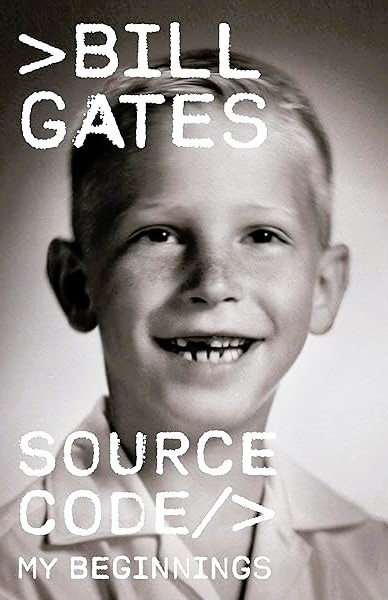
Source Code: My Beginnings by Bill Gates
In contrast to the current crop of swaggering tech bros, the Microsoft founder comes across as wry and self-deprecating in this memoir of starting out
Bill Gates is the John McEnroe of the tech world: once a snotty brat whom everyone loved to hate, now grown up into a beloved elder statesman. Former rivals, most notably Apple’s Steve Jobs, have since departed this dimension, while the Gates Foundation, focusing on unsexy but important technologies such as malaria nets, was doing “effective altruism” long before that became a fashionable term among philosophically minded tech bros. Time, then, to look back. In the first of what the author threatens will be a trilogy of memoirs, Gates recounts the first two decades of his life, from his birth in 1955 to the founding of Microsoft and its agreement to supply a version of the Basic programming language to Apple Computer in 1977.
He grows up in a pleasant suburb of Seattle with a lawyer father and a schoolteacher mother. His intellectual development is keyed to an origin scene in which he is fascinated by his grandmother’s skill at card games around the family dining table. The eight-year-old Gates realises that gin rummy and sevens are systems of dynamic data that the player can learn to manipulate.
As he tells it, Gates was a rather disruptive schoolchild, always playing the smart alec and not wanting to try too hard, until he first learned to use a computer terminal under the guidance of an influential maths teacher named Bill Dougall. (I wanted to learn more about this man than Gates supplies in a still extraordinary thumbnail sketch: “He had been a World War II Navy pilot and worked as an aeronautical engineer at Boeing. Somewhere along the way he earned a degree in French Literature from the Sorbonne in Paris on top of graduate degrees in engineering and education.”) Ah, the computer terminal. It is 1968, so the school terminal communicates with a mainframe elsewhere. Soon enough, the 13-year-old Gates has taught it to play noughts and crosses. He is hooked. He befriends another pupil, Paul Allen – who will later introduce him to alcohol and LSD – and together they pore over programming manuals deep into the night. Gates plans a vast simulation war game, but he and his friends get their first taste of writing actually useful software when they are asked to automate class scheduling after their school merges with another. Success with this leads the children, now calling themselves the Lakeside Programming Group, to write a payroll program for local businesses, and later to create software for traffic engineers.
There follows a smooth transition to Harvard, where in the ferment of anti-war campus protests our hero is more interested in the arrival, one day in 1969, of a PDP-10 computer. Gates takes classes in maths but also chemistry and the Greek classics. Realising he doesn’t have it in him to become a pure mathematician, he goes all-in on computers once a new home machine, the Altair, is announced. He and Paul Allen will write its Basic, having decided to call themselves “Micro-Soft”.
The early home computer scene, Gates notes, was a countercultural, hippy thing: cheap computers “represented a triumph of the masses against the monolithic corporations and establishment forces that controlled access to computing”, and so software was widely “shared”, or copied among people for free. It was Gates himself who, notoriously, pushed back against this culture when he found out most users of his Basic weren’t paying for it. By “stealing software”, he wrote in an open letter in 1976, “you prevent good software from being written. Who can afford to do professional work for nothing?” This rubbed a lot of people up the wrong way and still does, at least in the more militant parts of the “open-source” world. But he had a point. And that, readers, is why your Office 365 account just renewed for another year. Fans of Word and Excel, though, will have to wait for subsequent volumes of Gates’s recollections, as will those who want more about his later battles with Apple, though Steve Jobs does get an amusing walk-on part. (Micro-Soft’s general manager keeps a notebook of sales calls, on one page of which we read: “11.15 Steve Jobs calls. Was very rude.”). This volume, still, is more than just a geek’s inventory of early achievements. There is a genuine gratitude for influential mentors, and a wry mood of self-deprecation throughout. Gates gleefully records his first preschool report: “He seemed determined to impress us with his complete lack of concern for any phase of school life.” Later, he explains how he acquired a sudden interest in theatre classes. “Admittedly the main draw for me was the higher percentage of girls in drama. And since the main activity in the class was to read lines to each other, the odds were very good that I’d actually talk to one.” Strikingly, unlike most “self-made” billionaires, Gates emphasises the “unearned privilege” of his upbringing and the peculiar circumstances – “mostly out of my control” – that enabled his career. Adorably, he even admits to still having panic dreams about his university exams. The book’s most touching pages recount how one of his closest friends and colleagues in the programming group, Kent Evans, died in a mountaineering accident when he was 17. “Throughout my life, I have tended to deal with loss by avoiding it,” Gates writes. He says later that if he were growing up today, he would probably be identified as “on the autism spectrum”, and now regrets some of his early behaviour, though “I wouldn’t change the brain I was given for anything”. There is a sense of the writer, older and wiser, trying to redeem the past through understanding it better, a thing that no one has yet seen Elon Musk or Mark Zuckerberg attempt in public. That alone makes Bill Gates a more human tech titan than most of his rivals, past and present.
Daily inspiration. Discover more photos at Just for Books…?
7 notes
·
View notes
Text
There is something very weird about the relatively short nature of the culture surrounding website creation. As in, like, internet-user-created websites have been around for like 30-31 years at this point, and the culture surrounding them has changed so very much.
People used to create websites left and right for their own needs, their little shops and their little blogs about what they liked. Some websites of course housing horrible content since their dawn, and some being as mundane but as unique as the person behind its code. I have seen older sites, archived, that promoted creating your own site, and that was interesting to see. That culture of creating your own website and of sharing that knowledge on a still-growing facet of communication.
And then at some point social media appeared, and that was interesting, because now everyone was able to quickly present themselves without the need of a website, but that didn't mean people stopped making websites. I mean, hell, Geocities died in 2009, so a lot of people were creating their own websites for free before that time, no need to pay for domain names or hosting. And even without Geocities, there were other website hosting things that yes, while not as customizable, were still a resource for people to work with them. There's still a website floating around that I made when I was a kid using one of these services. Cool stuff.
All this to say that I do feel a weird sense of dread looking back and cross-referencing with the present and seeing things like "website creator powered by AI" and shit like that, because just ?? How did it go plummeting so quickly. There is a weird feeling of having lost a developing culture to corporations making quick access to posting things that, as corporations' nature dictates, are used to sell data or to train models or what have you. Similarly, we get pretty same-y looking pages because of the need to be slick or whatever with designs that just leaves everything looking the same. ALSO, the loss of spaces for kids, or just the gradual lowering of them in favor of cocomelons and whatever else the devil's machine has spawned is like watching an apple decay before having ripened. I do feel like there is this phenomenon in which how to make a site has been lost in the notion of "making a website falls into the realm of evil and scary coding and I could never be a programmer, plus who would look at it, plus we have tools to make them," etc etc etc. Here is a little secret: website creation is not exactly hard to pick up at all. You might say it's very similar to using a rich text editor like Word or a notes app or whatever you use. Similarly, have you used markdown for things like messages or D iscord messages, you know, with the asterisks for bold text and the likes? Markdown is based on html's structures. And truly, you do not have to even learn to code using Javascript if you don't want to, you can just go full html + css and structure your things as you go, adding your little images and your updates. Because guess what !! Html and css are not programming languages, they're a markup language and a stylesheet language respectively, which is a fancy way to say "you make the structure of your page with the first one and make it pretty with the second one". This includes cool stuff like tables, lists, grids, colors, transitions, etc. All of that without any programming. (That being said, if you are interested in programming, Javascript isn't too bad to pick up. The language itself *is* kind of evil, but using it in conjunction with html is not too difficult). I do have to say though, I am glad that there is a push to making your own websites and things, especially with Neocities sprawling a huge community of avid website creators, as well as the huge amount of tutorials and stuff making the push forward with making sites and online spaces and experiences more widely available. Hopefully this becomes a trend that keeps going up, considering the state of seemingly every single social media that has existed since the 2000s- 2010s.
#web#website#old web#dog discourse#ramblings#internet#computer#tech#but for real what the fuck#it's very bizarre to see this just pop in and out
7 notes
·
View notes
Text
When the Fat Girl Gets Skinny
the year of skinny pop and sugar free jello cups
we guzzled vitamin water and vodka
toasting to high school and survival complimenting each others collarbones
trying diets we found on the internet:
menthol cigarettes eating in front of a mirror
donating blood.
replacing meals with other practical hobbies like making flower crowns
or fainting
wondering why I haven't had my period in months why breakfast tastes like giving up
or how many more productive ways I could have spent my time today
besides googling the calories in the glue of a US envelope
watching America's Next Top Model like the gospel
hunching naked over a bathroom scale shrine crying into an empty bowl of cocoa puffs
because I only feel pretty when I'm hungry
If you are not recovering, you are dying.
By the time I was sixteen, I had already experienced being clinically overweight, underweight,
and obese.
As a child, Fat was the first word people used to describe me,
which didn’t offend me until I found out it was supposed to.
When I lost weight, my dad was so proud he started carrying my before-and-after photo
in his wallet.
so relieved he could stop worrying about me getting diabetes.
he saw a program on the news about the epidemic with obesity
says he is just so glad to finally see me taking care of myself.
If you develop an eating disorder when you are already thin to begin with,
you go to the hospital.
If you develop an eating disorder when you are not thin to begin with,
you are a success story.
So when I evaporated, of course everyone congratulated me on getting healthy.
Girls at school who never spoke to me before stopped me in the hallway to ask how I did it.
I say, I am sick.
They say No, you’re an inspiration.
How could I not fall in love with my illness?
With becoming the kind of silhouette people are supposed to fall in love with?
Why would I ever want to stop being hungry
when anorexia was the most interesting thing about me?
So how lucky it is, now, to be boring The way not going to the hospital is boring.
The way looking at an apple and seeing only an apple,
not sixty or half an hour of sit-ups is boring.
My story may not be as exciting as it used to,
but at least there is nothing left to count.
The calculator in my head finally stopped.
I used to love the feeling of drinking water on an empty stomach
waiting for the coolness to slip all the way down and land in the well,
not obsessed with being empty but afraid of being full.
I used to take pride in being able to feel cold in a warm room.
Now, I am proud I have stopped seeking revenge on this body.
This was the year of eating when I was hungry without punishing myself
and I know it sounds ridiculous, but that shit is hard.
When I was little, someone asked me what I wanted to be when I grew up,
and I said "small."
Blythe Baird
#ana#an0rec1a#ana quotes#ana quote#ana stuff#anatumblr#an0r3c1a#tw an0rexia#anorexcya#anorektyczki#anorexies#anorex14#anorexia quotes#sad anorexia quotes#anor3c1a#tw ed thoughts
16 notes
·
View notes
Text
It’s important to remember the beautiful encouragements of life; those people and ideas which push us to be better people.
My mother was a beautiful human. She encouraged volunteering whenever possible. We offered our time for our school/church’s MCREST program each and every year and she never hesitated on a food drive program opportunity.
Mom was a different kind of person. She was raised as the eldest in a family of 6 kids and she carried a naturally nurturing vibe. She offered her home to friends in need, housing my sister’s friend Sarah for so long she made some of our family pictures and even let an entire family live with us for about a year… it required a bit of sacrifice and adjustment… for the duration of their stay my sister lived with Dad and I lived with Mom and the family with their son, Logan.
She also let one of our stepdad’s friends… when he was still Scout Master Bob and not stepfather Bob, Jennifer live with us while she was temporarily stationed at Selfridge AFB.
One of her favorite things to do was help people understand things… she was a natural and connective teacher. Mom not only became a Catechism teacher but also offered to teach a student at my high school how to read. He was my girlfriend’s ex, Ben and he had dyslexia which discouraged him from trying and it seemed his parents couldn’t be bothered.
I did something similar with a kid in my 6th grade year, Jacob. Although I only offered my free time for him in class and mom legitimately sat down with Hooked on Phonics books and educated Ben.
One of the more profound things my mother did in my later teens was to help a roommate of mine, Vince find his last name. His parents had tried to change his whole name and while they faced challenges and disagreements between themselves, he was left on his own. I actually met him because a friend of mine said heard someone she knew had another friend who had been homeless for some time… and I offered him some space in my first apartment.
Mom gave us the heavy-duty convertible loft bed she bought when my sister’s friend lived with our family and also offered to shuttle this guy around the state in search of his social security number, birth certificate, ID, social security card and all his paperwork. I’m proud to say I used to drop him off at his first job for Michigan Works. His was the community which coerced me into weed and he himself had a friend he asked me to house… so I did. I suppose Mom was better with boundaries than I… yeah Boy Scouts taught me service and selflessness, just never taught me my limitations.
Mom advocated for social connections and festivals like our Catholic school’s Apple Fest and local town’s Peach Fest and Steam Engine Show… we attended every year along with the Renaissance Festival.
We never hesitated when Mom’s family had a gathering at our Uncle’s pole barn. When one person celebrated, we found ways for everyone to celebrate each other. Nobody had exorbitant funds… we just cared that much about supporting each other as a family and family meant friends, too.
Our uncle frequently hosted fish fries for which everyone offered their time filleting and preparing his blue gill catches while he would fry them up and set them out for people.
I still have photos of a few gatherings with everyone huddled around a row of folding tables and a game of penny poker going.
Mom’s family is a truly wonderful community who seemed to drift a little after grandpa passed away. Mom herself was also a stickler for Mass services. We hosted a weekly pizza and movie night with doors open for friends and when they stayed the weekend, everyone was required to attend Mass either Saturday night or Sunday morning. She’d make breakfast like omelettes or silver dollar pancakes and we’d dress our best.
Eventually, Mom worked for and I believe she retired from the Autism Society of Michigan after spending much of her time volunteering to help “her kids” (young adults on the spectrum) learn life skills and develop community and routine.
Life offers us so many opportunities to be kind and collaborative… it’s our choice to step up for that. We don’t need material wealth to do it. Sometimes it helps. Dad was fun, too. He offered his boat for friends to drive up to Strawberry Island or some shallow bay.
2 notes
·
View notes
Text
WORK ETHIC AND DIFFERENCE
If you don't know that number, they're successful for that week. Founders understand their companies better than investors, and it also tends to make startups more pliable in negotiations, since they're usually short of money. Third, Pantel and Lin do, but I haven't tried that yet. By obstructing that process, Apple is making them do bad work, and indignant readers will send you references to all the papers you should have cited. If you write software to teach English to Chinese speakers, however, tell A who B is. You have to decide what to do next. Seeing a painting they recognize from reproductions is so overwhelming that their response to it as a way to generate deal flow for series A rounds, the investors won't take as much equity as VCs do now. The second will be easier.
Would it make the painting better if I changed that part? I heard about after the Slashdot article was Bill Yerazunis' CRM114. It would be a crapshoot. If good art is that it makes you more confident, and an investors' opinion of you is the opinion of other investors. They could grow the company on its own revenues, but the extra money and help supplied by VCs will let them grow even faster. It makes a better story that a company won because its founders were so smart. Why should anyone care about a startup making $3000 a month? There are four main reasons: Moore's law has made hardware cheap; open source has made software free; the web has made marketing and distribution free; and more powerful programming languages mean development teams can be smaller.
Would it make the painting better if I changed that part? 9999 free! So this alternative device probably couldn't win on general appeal. Well, not quite. But ultimately the reason these delays exist is that they're more prestigious. I think he really wishes he'd listened. Instead everyone is just supposed to explore their own personal vision. At least one startup from the most recent summer cycle may not even be an accurate measure of the bugs in my implementation than some intrinsic false positive rate of Bayesian filtering. Once you start talking about audiences, you don't have x.
Here are the alternatives considered if the filter sees FREE! When one investor wants to invest in startups, and in those the first word is a verb. That difference is why there's a distinct word, startup, for companies designed to grow fast, I mean it in two senses. In fact, one of the reasons taste is subjective found such a receptive audience is that, historically, the things people have said about good taste have generally been such nonsense. When I was in art school, we were looking one day at a slide of some great fifteenth century painting, and one of the reasons artists in fifteenth century Florence to explain in person to Leonardo & Co. Is the future of venture funding will be like, just ask: how would founders like it to be? They're so attracted to the iPhone that they can't leave. Which is of course a recipe for deadlock, and delay is the thing a startup can least afford. The investors who invested when you had no money were taking more risk, and are entitled to higher returns. It would feel unnatural to him to behave any other way. Another wrote: I believe that they think their approval process helps users by ensuring quality.
In a traditional series A round. Startups are increasingly raising money on convertible notes, and convertible notes have not valuations but at most valuation caps: caps on what the effective valuation will be when the debt converts to equity in a later round, or upon acquisition if that happens first. When the economy bounces back in a few unusual cases. One of the mistakes novice pilots make is overcontrolling the aircraft: applying corrections too vigorously, so the aircraft oscillates about the desired configuration instead of approaching it asymptotically. Worse for Apple, these apps work just fine on other platforms that have immediate approval processes. If they decide to grow at 7% a week and they hit that number, they're successful for that week. And open and good is what Macs are again, finally. One way to deal with this is to treat some as more interesting than others. Now the good news: investors may actually make more money as a result. One is the type that pretends to be an old and buggy one. When you notice a whiff of dishonesty coming from some kind of art, stop and figure out what it's doing.
One of our axioms at Y Combinator is not to compile a complete list, just to show that there's some solid ground here. Startups hate this as well, partly because there was a widespread feeling among potential founders. If we assume the average startup runs for 6 years and a partner can bear to be on the board to help a startup. In this case the super-angel, who operates like an angel, but using other people's money, like a VC. There will continue to be lead investors in the attitudes of existing startups we've funded. Roughly, it's something done with contempt for the audience. Now for the really shocking news: during that same one-month period I got three false positives. Millions of companies are started every year in the US. I'm optimistic about are ones that calculate probabilities based on each individual user's mail.
I called a huge, unexploited opportunity in startup funding: the growing disconnect between VCs, whose current business model requires them to invest large amounts, and a party reminder from Evite. In a sufficiently connected and unpredictable world, you can't seem good without actually being good. How could they go ahead with the deal? VCs who try to compete with angels by doing more, smaller deals will probably find they have to take less equity to do it is to get the best deals, the way to do it is to get the first commitment, because much of the company they do now. Maybe the only answer is a central list of domains advertised in spams. Apple is trying to be with the App Store? This pattern is repeated over and over. If you had, surely you'd be just as attached to that name as you are to your current one. 03% false positives. And someone has to argue with you except yourself. But that might not be necessary.
A rapidly growing company is not merely valuable but dangerous too. If you start to get far along the track toward an offer with one firm, it will make the spammers' optimization loop, what programmers would call their edit-compile-test cycle, appallingly slow. That isn't happening this time, and part of the money. Or to put it more prosaically, they're the people who are genuinely good. It comes with a lot of time trying to learn how to predict which startups will succeed. This is the fourth way in which offers beget offers. Most people don't know how ambitious to be, especially when they're young. If you cared about design, you could buy a Thinkpad, which was still then a quasi-government entity. I just mentioned.
#automatically generated text#Markov chains#Paul Graham#Python#Patrick Mooney#disconnect#kind#way#recipe#audience#track#web#debt#result#filter#VCs#startups#everyone#others#reasons#board#Moore#valuation#CRM114#reproductions#stop#beget#money#distribution#angel
2 notes
·
View notes
Text
I want to formally write up my digital note-taking system as someone with autism and ADHD at some point, complete with screenshots. I've always been trying to reduce it and simplify it but I've accepted that it's always going to be difficult for other people to implement because I'm obsessed with organization and have been refining the system over years.
I've been reading Building a Second Brain by Tiago Forte and have loosely adapted the PARA concept (Projects, Areas, Resource, Archives). I think it's brilliant to make notes more actionable. I want to organize such that it's easier to access notes most useful to me, and less-relevant-and-immediately-actionable notes like resources and finished projects are kept but neatly put away for later use and not cluttering up the space.
Basically, most of my personal and reference notes are in Notion. There I keep a list of things like my goals, my spending, my project planning, and reference materials I've collected over the years related to things like health, career development, recipes, etc.
However, Notion is a clunky experience on mobile. There is also no offline support - well, not proper offline support, anyway. That's because it's fundamentally a web application.
For quick notes I take on the go, reminders, and shopping lists, I use Google Keep. I can't understate how I haven't found a better app for this. Imagine a dynamic sticky notes board that syncs across devices and is easy to add and remove from. I can send notes to myself in the future in less than a minute and it basically runs my life. Every so often, I copy down important notes from Google Keep into Notion. I think basically everyone should use Google Keep, but especially for people with ADHD. Often we think of things in the moment, but they aren't relevant. I always jot down something I remember and send a reminder to myself when I can take action with it.
Finally, as much as I think Notion is great for note-taking, I actually use Obsidian for any deeper knowledge databases. I'm going to experiment and use Obsidian as my main school notes hub when I go back to school. I have a personal Obsidian wiki for programming. Obsidian is essentially offline Notion with less emphasis on databases. The linking between pages and seeing a map of how concepts are related to one another is extremely powerful.
And although I don't use it as often, I really like Notability on my iPad with an Apple Pencil. I use it for making digitized diagrams and as a study tool. The act of writing over typing codifies things in my memory.
I used to use Microsoft OneNote a lot. I miss when it was free. I appreciated how flexible it was. I used a tablet to write directly on the pages. However, I found that I hated formatting in it over time, and I preferred using Markdown as it's more universal. (Even my resume is written in LaTeX. I used to code every assignment in HTML/CSS because I wanted perfect formatting.) Overall, OneNote was clunky and difficult to keep consistently formatted.
On top of my digital system, I have a physical bullet journal and whiteboards. I think having multiple spaces that remind of of my tasks and ideas and to jot them down, and then moving them around helps me remember them. I could streamline the process a bit, but I really don't like compromising physical note-taking. I'm a firm believer in physical and non-cloud backups of information. I don't want to put all of my eggs in one basket and rely on Internet infrastructure. I also want to feel grounded. There are some hybrid digital/physical notebooks I might look into to keep the process simple, but I've been working with this system fine.
2 notes
·
View notes
Note
I love your OC art and I was wondering how you're able to make them. Is there a website you use or a template you follow? I'd love to make my own OC's but don't know how/where to start
Hey there Anon! So sorry for the lag in the response, I wanted to be sure I could give you an in depth answer! It’s gonna be long, so I’ll put a Read More here~ if you have any questions, feel free to dm me!
Lemme start by saying, Thank you so much! You’re so sweet! 😭😭 it seriously makes my day to hear that, you don’t even know 😭🖤
Secondly, as for Remi and Levi, both characters started out as roleplay characters that @thekinkyleopard and I came up with about 10 years ago! The characters themselves have evolved over the years as we’ve done a hundred different storylines and bounced ideas off of each other. Draeko, on the other hand, was created less than 6 months ago, so he’s not as in depth of a character.
Now, I’ve been doing art for as long as I can remember, and creating characters has always been something I love doing. But everyone creates an OC differently. Personally, I always start with the visualization of a new character, first.
Like for instance, for Draeko, I started with just a color pallet, (ie, pastel pink, white, pastel mint green, and pink plaid). And because I’m a furry, most of my OC’s usually have an attachment of some kind to an animal (shifters, or my Hellhound), plus I wanted more of a complex character since Remi was so plain.
I started drawing a reference sheet for him, which is pretty much a large, informational sheet with your OC in a bunch of different angles, along with key information, accessories, or whatever you want people to know about your character. Here’s some examples of reference sheets I’ve done for our OCs:
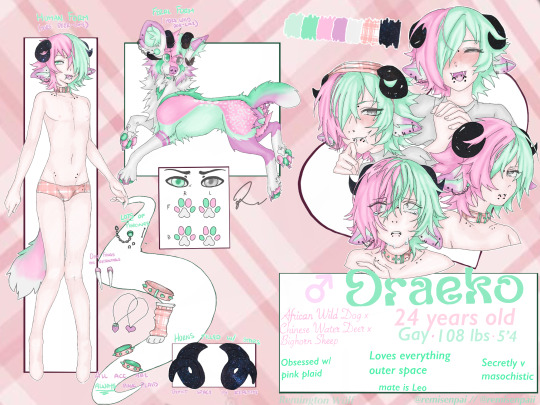
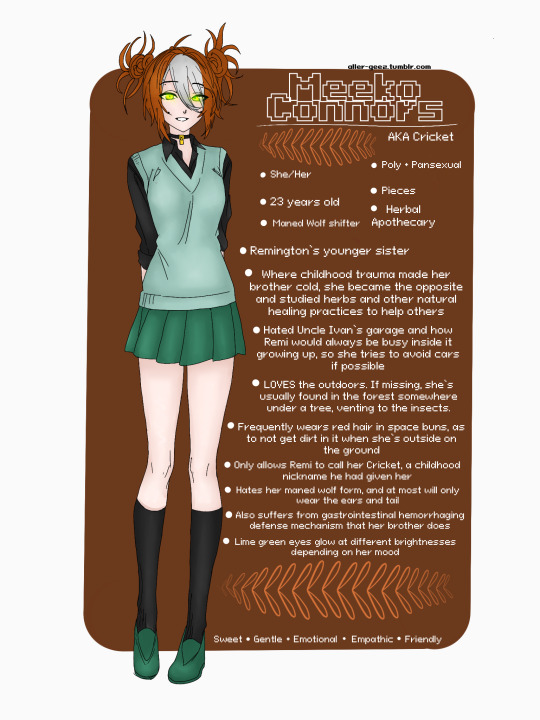
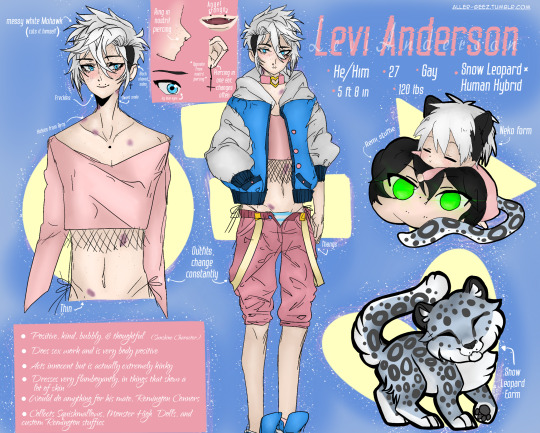
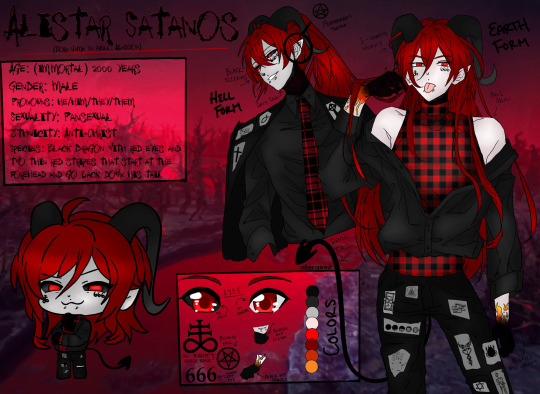
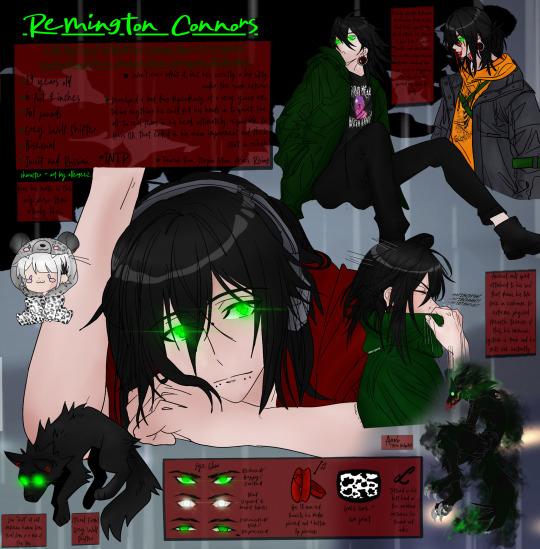
I usually start with the full body view first, coming up with details to add as I go.
(Most of my OC’s started out as fursonas, so they already had their animal form, I just would need to design a human form that matched it.)
I then come up with their personality as I’m adding details, and accessories, and naming them. And very last, I come up the details for their backstory, as well as any lore I can come up with.
HOWEVER
Everyone creates differently, and if you’re someone without much art experience or just don’t have a want to create art, OR if that just seems backwards to you,
An easy, pain free way to create your own in depth character that can just always live in your head, or one that you commission another artist to bring to life for you, they have these AMAZING character development type sheets that you can fill out, essentially making a written Reference Sheet so someone else can imagine (or bring to life) your character accurately. Here’s just a few I found in Pinterest by looking up “character development sheet”
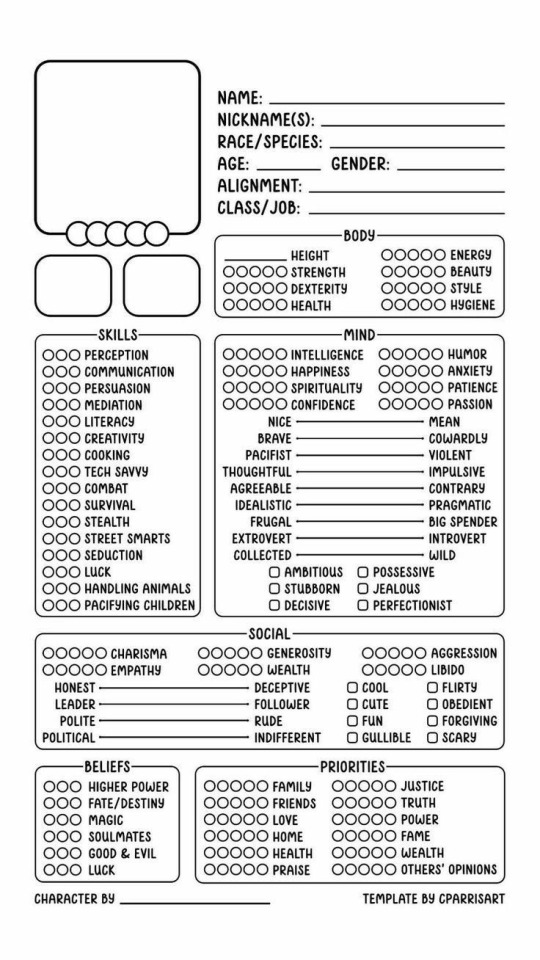
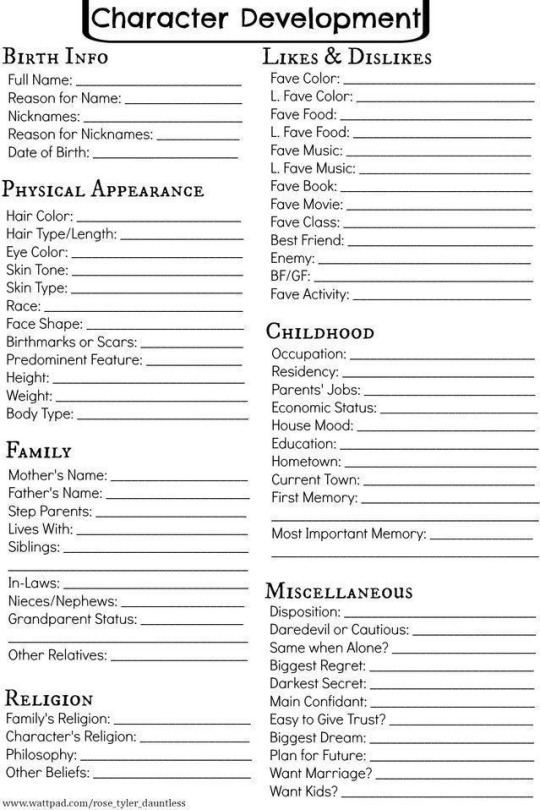
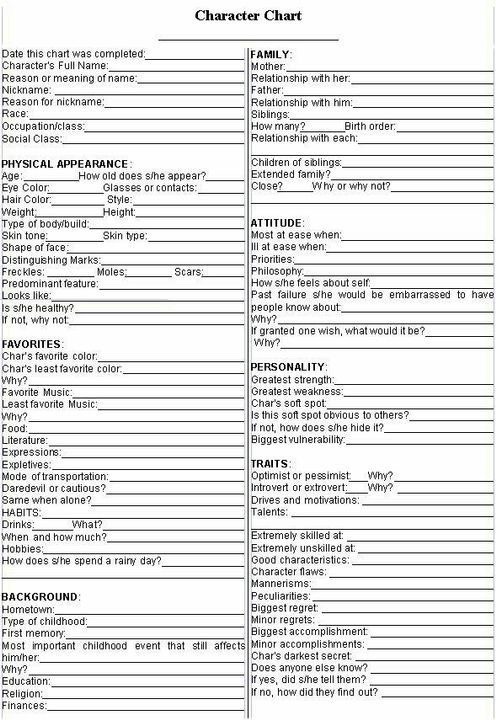
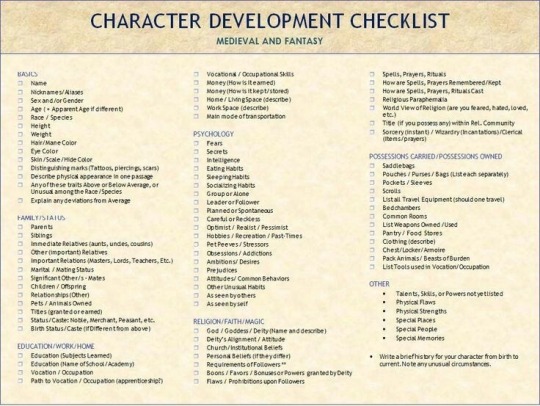
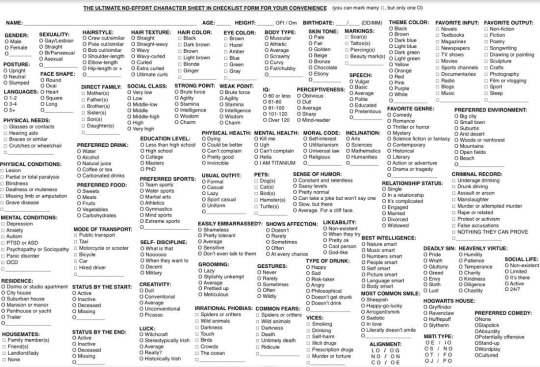
As for how I create my art, I use an iPad and Apple Pencil, along with the program Procreate to freehand draw (or I also use bases or pose references from Pinterest!) all of my art from scratch!
Sorry if this is way longer of an answer than you were hoping for/expecting, but I wanted to cover as many points as I possibly could!
Like I said at the top of the post though, if this doesn’t make sense or if you have any other questions about it, shoot me a dm! I promise I don’t bite, I just suck at replying to messages (:
11 notes
·
View notes
Text
China took everyone to an unprecedented surprise in heated dominance in AI industry as Deepseek seemed to have knocked ChatGPT out of their perch. Deepseek programme was released on January 20, a week later it hits top of Apple’s App Store chart. Deepseek is a Chinese AI startup founded in 2023 by Laing Feng, an entrepreneur and businessman. In January, Deepseek released latest model of its programme- Deepseek R1, a free AI-powered chatbot with resemblance as ChatGPT, with improved features which leaves OpenAI company running behind. Chatbots are computer programmes which duplicate human-style conversation with a user. When a user ask questions it generates response from information it has been trained with.
Generative AI has become popular especially the ability to have conversations with a user, this is the aspect of the AI that has evolved human conversation, the response feel real but you can argue that it lacks the needed empathy to make it resonates. The reliance on generative AI has grown, people are looking at the most effective response that’s where heated dominance in tech industry will define the role of Deepseek and ChatGPT which goes down on users reliance as the most effective. Developers of Deepseek said it is cheaper to build, which followed the article they published on December stating that it require less than $6million. This is no way compared to multi-billion dollar budget shared between US tech giants; ChatGPT and Gemini, powered by OpenAI and US-owned Google respectively.
Nvidia, lost nearly $600billion in market capitalization, as a result of Deepseek exploits at its release, Nvidia, American multinational which holds almost monopoly on making semiconductors for generative AI recorded this lost when the share price declined by 17 percent. However, security issues surrounding Deepseek have been heavily feared by many countries as they tend to ban the AI software. US space agency NASA, has prohibited Deepseek from its systems and devices of its employees, US Navy has admonished its members against using the software citing serious security concerns and handling of personal data, US lawmakers are not ruling out the possibility introducing a bill to ban the software from government owned devices.
Australia, Taiwan and South Korea have blocked Deepseek from government owned devices, while Italy is still seeking clarity on how Deepseek tend to use personal data and also citing security concerns. CEO of Feroot Security, an Ontario-based cybersecurity firm, Ivan Tsarynny, claimed that Deepseek “has code hidden in its programming which has the built-in capability to send user data directly to the Chinese government”. This has been the same security concerns surrounding Tiktok which led to the prospect of its ban in America. China refused to be side-lined in all these bans flying around their software and has replicated the retaliatory attack by blocking all users in China from access to Facebook, X and Deepseek counterpart, ChatGPT. It is about how these technologies evolve off security concerns and fear of mishandling of personal data.
https://anthonyemmanuel.com/flexing-of-tech-muscles-reach-all-time-high-as-deepseek-and-chatgpt-lock-horns-in-heated-dominance/
#DeepSeek #DeepSeekR1 #DeepSeekAI #deepseek #openai #chatgpt #technology #tech #TechInnovation
1 note
·
View note
Text
10 Reasons to Learn React Native for App Development
Are you interested in learning React Native for app development? If yes then you need to be aware of the reasons to learn React Native for app development. And that you will get easily in this article.
In the rapidly evolving landscape of mobile app development, choosing the right framework can be a critical decision. React Native, a JavaScript framework developed by Facebook, has emerged as a powerhouse, revolutionizing the way developers approach app creation. Let's delve into the ten compelling reasons why learning React Native for app development is not just beneficial but often essential.
What is the React Native framework?
React Native is a flexible framework that can be used for a wide range of development projects in different industries and sizes. It offers both conventional and cutting-edge techniques for creating hybrid mobile applications. Not only does React Native make it easier to create cross-platform mobile apps for iOS and Android, but it also lets developers tweak it to create web apps for Mac and Windows.
However, there are a few options available to you in 2024, if you wish to pursue an app development career. For instance, you can study iOS or Android if you want to design native apps, but in 2024, you can choose to learn Flutter or React Native if you want to create cross-platform apps that function on other platforms in addition to iOS and Android.
Android has always been my favorite platform because you can write Android applications using the Java programming language. If you are a Java developer, this was the simplest way to start in the field of app development. However, if you have experience with JavaScript, learning Java or Swift—which is necessary for developing iOS apps—might be challenging.
Alternatively, you can continue with JavaScript and study React Native, which is, in my opinion, the greatest option for a JavaScript developer to get into App development in 2024. You can also learn Dart to use Flutter.
This article will discuss 10 reasons to study React Native, which will help you decide which technology to learn for app development in 2024. In the past, I have published the top React Native Courses as well as free React Native courses for beginners.
Mobile technology developed at a breakneck pace over the past ten years. Originally, the primary uses of mobile phones were for SMS/MMS and phone calls. But much has changed since the release of Android. More than just communication tools, mobile phones are more.
You get access to the internet, games, movies, photo editing, video editing, and more. The Play Store boasts more than 3.4 million applications. Additionally, there are more than 2.2 million apps available on Apple's App Store. One of the main causes of the abundance of apps in the play store and app store is the ease of internet access.
Everyone wants to get into the realm of mobile applications these days. Businesses are promoting their products using mobile applications at an increasing rate. People are employing their own mobile applications as well.
Nearly anything has an application available on the Play Store and App Store. Even websites are developing mobile versions in response to the growing popularity of mobile applications. For instance, Amazon, one of the most widely used websites, has a mobile version as well.
Mobile apps used to be very basic. Performance was not discussed very much. However, a high-performing application is now what everyone wants. Developers began to improve frameworks in order to construct better mobile applications as a result of these demands. One of the most widely used frameworks for developing mobile applications is React Native.
Cross-platform mobile applications with a native feel can be created with React Native. It has become incredibly well-known in the last few years. It is currently a popular subject in the developer community. We'll outline ten arguments in this post to help you see why learning React native is necessary in 2024.
Why Develop Mobile Apps Using React Native in 2024?
The top ten justifications for learning the React Native framework or library in 2024 are listed below for creating mobile applications.
Apps built with React Native are cross-platform: The platform independence of react native apps is perhaps the main argument in favor of learning it in 2024. In the past, programmers primarily used Java to create Android apps and Swift to create iOS apps.
There are more systems available in addition to this, like Windows. This was problematic, then. One of the greatest options for creating cross-platform applications is React Native. An application that you design will function across all platforms.
Web developers find it easier to learn: It's difficult to pick up a framework from scratch. However, if you work as a web developer or are familiar with fundamental web technologies like JavaScript and CSS, you will quickly pick up on React native.
It's because web technologies are used by React native. React native will also not be a huge difficulty for you if you are a Ract.js developer because it is greatly inspired by the JavaScript library.
Both live and hot reloading: When a file changes, live reloading means reloading or refreshing the entire application; hot reloading, on the other hand, means refreshing the files that have changed without affecting the application's current state.
React native frameworks are particularly developer-friendly because of these two qualities. These features make it easier for developers to test the components. These also save a great deal of time.
Productivity: The process of creating mobile applications takes time. However, React native is renowned for its increased output. We're creating a single application to run on several different platforms. It is quite time-saving. Furthermore, with React native, quality is not sacrificed.
JSX: React Native employs JSX. It's evident that JSX is user-friendly if you are familiar with React. Numerous people claim that JSX is a hybrid of JavaScript and HTML. It will therefore not be too hard to learn React Native.
While some concepts may be difficult to grasp, it is not difficult because there are no intricate programming languages involved. Java is not as easy to use when building applications as React native is.
Native components: Numerous alternative cross-platform frameworks exist. Yet native components are used in React Native. The rendering and execution speeds are increased by native components.
Robust Community: React Native is not that old. It was released only six years ago. Nevertheless, React native boasts a robust community due to its widespread adoption. On Stack Overflow, there are more than 100,000 queries labeled as "React native."
For new technology, that is a significant figure. It is almost one hundred thousand stars on GitHub. This is sufficient evidence that the React Native community is robust and continues to grow annually.
Simple to update: It's possible that after publishing an application, adjustments will be necessary. Now, this can be a difficult circumstance. Everything you complete before to releasing the application must be done again.
The build procedure must be repeated, the application must be republished, and you must then wait for approval. It takes a lot of time to do this. However, React native makes it simple to update an application. The app is automatically updated while it is running thanks to React Native's Code push feature. This reduces work and saves time.
Use of third-party libraries: React native is extremely flexible, much like React. With React Native, we can leverage a multitude of third-party libraries to streamline our work. For instance, we may utilize a number of testing libraries with React Native, like Mocha and Chai.
The incredibly clever Redux can be used for state management. React native can also be used with lining tools like ESLint. While developing, third-party libraries can be really helpful. One of the main factors influencing people's preference for React Native is its versatility.
high-paying positions: There is a significant demand for mobile applications, as was previously indicated. Mobile applications are used by everyone, including individuals and products. In the world of developing mobile applications, React native has gained a lot of popularity.
React native is becoming more and more popular for mobile applications. Because of this, there is a great need for experienced React native developers. Such talented coders are being paid enormous wages by companies. React Native is a great option if your goal is to land a high-paying position.
The question now is, how can one learn React Native, given that it can change the game for cross-platform app development? Which books to read and which courses to enroll in?
You don't have to worry about that because I've already published the greatest paid and free resources to learn React Native. Check them out to get started with React Native in 2024.
In conclusion, React Native's widespread adoption in the app development community is not without reason. Its cross-platform compatibility, cost-effectiveness, and robust features make it a go-to choice for developers aiming to create high-performance, feature-rich mobile applications.
If you want to read more information visit us.
0 notes
Link
#FreeCoursesOnlineCertificates#FreeCoursesOnlineResources#FreeCoursesOnlineTipsandTricks#FreeOnlineCourses
0 notes
Text
Convert Website to Mobile App with Our Expert Team
Transforming your website into a mobile app can revolutionize how users interact with your brand. With the growing reliance on mobile devices, having a dedicated mobile app not only improves user experience but also boosts engagement and brand visibility. If you’re looking to Convert Website to Mobile App our expert team at Web View Gold is here to guide you through the process seamlessly and professionally.
Why Convert Website to Mobile App?
Before diving into the details, let’s explore why converting website to mobile app is essential for businesses today:
1. Enhanced User Experience Mobile apps provide a faster, smoother, and more personalized experience compared to websites. They allow for features like offline access, push notifications, and quick load times, making it easier for users to navigate and engage with your content.
2. Increased Accessibility Having a dedicated mobile app ensures that your services or products are always at your users’ fingertips. Whether on Android or iOS, your app will make your business more accessible and convenient to use.
3. Higher Engagement Rates Push notifications, in-app messaging, and offline features help keep users engaged with your content. Apps also offer better integration with device features, such as cameras and location services, providing a more interactive experience.
4. Broader Reach and Visibility Publishing your app on the Google Play Store and Apple App Store makes it accessible to millions of users, significantly expanding your potential audience.
Why Choose Our Expert Team at Web View Gold?
Converting your website to mobile app can be a complex task, but with our expert team, it’s streamlined and stress-free. Here’s why Web View Gold is the ideal solution:
1. No Coding Required Our team handles the technical aspects of convert website to mobile app, so you don’t need any programming experience. We use Web View Gold, a tool designed to make the process accessible to everyone, from beginners to seasoned professionals.
2. Cross-Platform Expertise Whether you’re targeting Android, iOS, or both, our team ensures your app functions seamlessly across all platforms. We take care of any technical challenges related to platform compatibility, ensuring a smooth user experience for all.
3. Customization Services We offer customization options tailored to your brand’s needs. From adding splash screens and loading indicators to incorporating push notifications and offline access, we make sure your app reflects your unique brand identity.
4. Comprehensive Support Our expert team provides guidance at every step of the convert website to mobile app process. From linking your website’s URL to compiling and publishing the app, we’re here to support you through every phase.
The Process of Converting Your Website to Mobile App
Step 1: Consultation Start with a free consultation where we discuss your goals, target audience, and the specific features you want in your app.
Step 2: Download Web View Gold Our team will provide you with the Web View Gold template tailored to your needs.
Step 3: Link Your Website We will input your website’s URL into the Web View Gold template, ensuring all your website’s content is available in the app.
Step 4: Customize Your App Choose from a range of customization options, including push notifications, offline capabilities, and personalized splash screens.
Step 5: Compile and Test Our team will compile the app and test it across multiple devices to ensure it works seamlessly.
Step 6: Publish Your App We assist with the submission process to the Google Play Store and Apple App Store, ensuring your app is ready to reach the widest audience possible.
Why Choose Web View Gold for Your Website to Mobile App Conversion?
1. Cost-Effective Solution Traditional app development can be expensive and time-consuming. Web View Gold offers an affordable alternative without sacrificing quality.
2. Faster Deployment With Web View Gold, you can convert your website to mobile app in days, not months.
3. Real-Time Updates Any changes made to your website are automatically reflected in your app, ensuring your content is always current.
4. Enhanced User Engagement Push notifications and offline capabilities allow you to communicate directly with your users, increasing engagement and loyalty.
Conclusion
Converting your website to mobile app is a strategic move to improve user experience and expand your brand’s reach. With the expert team at Web View Gold, you can take this crucial step with confidence.
0 notes
Text

Progress Update #8 - The final touches?
In this update, I'll be going over the finishing touches before the "demo's release". Not everything in this update will touch upon AI, as this post purely serves as a general project progress update.
First off, the demo now has a working title screen (still in development, may not be final demo look). There is no loading screen as of right now, however, upon pressing "Play", it boots the player straight into the level of the game, also presented with a dialogue box (starting dialogue messages are chosen at random and teaches the player what to do)

Text messages are also present in the game, as upon picking up an item, such as a key, the game will tell you that you obtained the specific item.
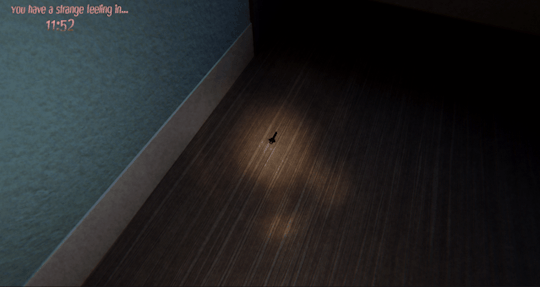
Walking sound effects, background ambience, and event sound effects have also been added to the game very easily by placing a sound effect component onto an empty in the scene.
Upon obtaining the game controller from the first two updates, not only does the TV light up now, but also, the game's background has been implemented and a post processing effect was added to give the illusion of the player being in the old television, revealing screenlines. The minigame's background was designed by me using PixilArt, a free online source for making 2D sprites, and the same programmed used to make the apple and bucket sprites.
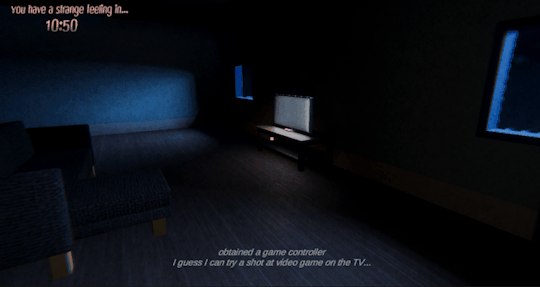
A little bit of code that I created after being guided by ChatGPT as to how I should go about creating different codes, I decided to use some of that knowledge for another task implemented, which correlates to a keypad found on one of the doors in the map. The code utilizes the bool system and randomness factors used to generate the correct code, only this time, I can't tell you guys how to find the passcode ;)
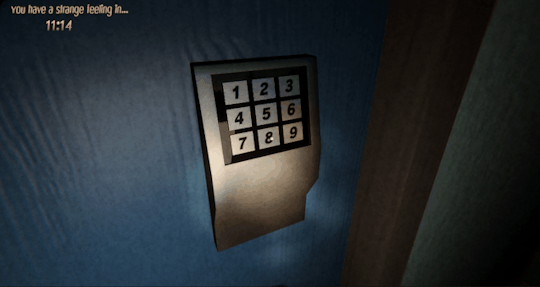
hehe..
A Game Over sequence is also commenced upon not escaping the map within the 12 minute time limit the player is given. As time goes on, the player will have different dialogue boxes that reminds the player of time running out, as well as giving hints as to where to look for clues next. These dialogues are not given depending on player task progression, but rather, the message given is at random depending on the time remaining, found at the top left of the screen.
Last, but not least, I made some fine tweakings to the codes made from the last several progress updates, and I can't wait to share to everyone the prototype/demo of this game.
0 notes
Text
youtube
Hire A Mentor #shorts
Private Money Academy Conference:
Free Report:
Watch the Full Interview at:
youtube
“Discipline, Focus, and Resilience: Real Estate Lessons from a Black Belt, Sam Wegert”
Sam Wegert was homeschooled K-12 with his seven siblings. At 15 years old, with a loan of $15,000 from his parents, he purchased his first martial arts school and graduated high school that same year.
Over the next 15 years, he expanded to 6 brick and mortar locations and through COVID built an online program. His company, UpLevel Martial Arts now has over 1,500 students and has trained more than 20,000 students in martial arts in 25 states and 3 provinces in Canada.
Throughout his martial arts career, Sam joined GoBundance as the youngest member at the time in 2014 and began to invest in real estate through short-term rentals and co-living properties. He partnered with his wife and now together they own 8 short-term rentals and 115 co-living beds.
Sam is now passive in both his real estate investments and his martial arts business and lives in Charlotte, NC with his wife Rachel who is a HUGE supporter and his business partner.
As a coach in entrepreneurship, real estate, and martial arts, Sam helps people identify and overcome the obstacles in their lives so they can pursue their passions.
He knows that everyone has the potential to achieve great things, and he’s dedicated to helping them reach their full potential. He has an uncanny ability to quickly diagnose the root of a problem and provide a solution that is tailored to each individual.
Whether you’re looking to start your own business, buy a new home, or learn self-defense, Sam can help you achieve your goals.
Sam is the Co-Author of The Modern-Day Blackbelt. Bill and Sam Wegert, father and son, share stories of how their homeschooled family of eight kids got involved in martial arts.
The book describes the innovative training program called UpLevel Martial Arts that Sam, along with his three rock-star siblings, Tim, Abbey, and William, Jr. developed that is strengthening families and preparing young people for life.
Along with an amazing team of instructors, UpLevel has trained over 15,000 students to become Modern-Day Black Belts across the United States and worldwide through the cutting-edge UpLevel @Home Academy. This book explains how they do it and how you can get involved.
Join the Private Money Academy:
Have you read Jay’s new book: Where to Get The Money Now?
It is available FREE (all you pay is the shipping and handling) at
What is Private Money? Real Estate Investing with Jay Conner
Jay Conner is a proven real estate investment leader. He maximizes creative methods to buy and sell properties with profits averaging $67,000 per deal without using his own money or credit.
What is Real Estate Investing? Live Private Money Academy Conference
youtube
YouTube Channel
Apple Podcasts:
Facebook:
#youtube#flipping houses#jay conner#private money#raising private money#real estate#real estate investing#foreclosures#real estate investing for beginners#passive income
0 notes
Text
Using Storyline Online
I took a look at an online resource called ���Storyline Online’ – a website created by the SAG-AFTRA foundation that provides videos of various actors reading children’s books. It is accessible via a web browser, but even has applications on the Apple Store and Google Play Store for easier access on devices such as phones and tablets. In my perusal, I investigated all potential tools at my disposal; the biggest and most notable being the extensive library of book readings. For easy viewing, they’re divided into alphabetical order – though there is a section for new uploads of the month – and each book has a list consisting of author and illustrator, publisher and recommended grade level. Unique to the website’s purpose, the list also includes the actor reading in the video, and the video’s run time.
I found this site to be cool and innovative; audiobooks have been around for a long time, but they’re mostly targeted towards teenagers and adults than younger children. Storyline Online’s ‘about us’ description states “Reading aloud to children has been shown to improve reading, writing and communication skills, logical thinking and concentration, and general academic aptitude, as well as inspire a lifelong love of reading.” (Storyline Online, 2024) which is evident in the way they’ve presented this program. All of the videos are hosted via YouTube or SchoolTube, making them free and accessible to anyone who’s interested. This is much like a digital library – it saves people, especially children who may not have access to their own money due to their age, from having to buy books and still have the opportunity to read or listen. Reading has always been integral to learning; it’s entirely ingrained in everyone’s daily life, and is taught from a young age for a reason. Research shows that “Reading clearly exposes young people to new vocabulary, so the link between reading for pleasure and vocabulary development is to be expected,” (Sullivan, 2015) – a notion that is shared by Storyline Online. As stated previously, they took the learning aspect of reading and combined it with the appeal of books found enjoyable by children, read by famous actors to create a valuable tool that combines education and entertainment.
Since childhood, I’ve always been someone who enjoys reading, so I’ve never needed to be encouraged to do so. However, I know that’s not the same for many other children – I grew up around plenty of people who didn’t see the appeal of reading for fun. At the same time, television and film has always been a big interest of mine and many others, so if this resource had been around at the time when I was still in primary school, I wonder if many people would be inclined to engage to see their favourite actors. The website also states that “Teachers use Storyline Online in their classrooms, and doctors and nurses play Storyline Online in children’s hospitals,” (Storyline Online, 2024) and I can certainly see why; it’s similar to a story time session, where the teacher reads the book to their class. Storyline Online can be taken outside of that context and watched anywhere, which is one of the appeals. I’m unsure how well it would always fare in an educational setting – it might discourage students from actually reading, but reading isn’t suited for everyone so if listening to books is easier and a student feels motivated to do so, then it can’t be a bad thing.
References:
Beck, I. L., & McKeown, M. G. (2001). Text talk: capturing the benefits of read-aloud experiences for young children. The Reading Teacher, 55(1), 10–20. https://www-jstor-org.ezproxy.csu.edu.au/stable/20205005
SAG-AFTRA Foundation. (2024). Storyline Online. Storylineonline.net. https://storylineonline.net/
Sullivan, A. (2015). The life-long benefits of reading for pleasure. The SL, 63(1). https://cls.ucl.ac.uk/wp-content/uploads/2017/02/School_Librarian.pdf
0 notes